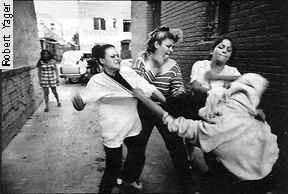|

Teen-age Girls in Smaller Cities Becoming Involved in Gangs
A
Feature By Deborah Mendez
In Denver, Colorado, Santina has just completed two years probation for assault
with intent to kill and is sitting on a dirty carpet in the public defender's office.
The 16-year-old former
gang member wraps her arms around her lanky legs and ticks off her finer qualities to a dozen other girls around her.
"I'm
a good friend. I'm taking classes. I'm gonna get a fast car,'' she says, her kohl-rimmed hazel eyes seeking approval.
She
and the other teen-agers, all self-described "bangers,'' have been ordered by a judge to attend the self-esteem-building group
sessions organized by the city's Gang Rescue and Support Project, or GRASP.
Most are either hanging
out with male gangs or trying to get away from them. Curfew violations, physical assaults and possession of concealed weapons
have spiked them into the criminal justice system.
They are among the thousands of young women - some as
young as 12 - who, in a misguided search for respect and glamour, join or "kick it'' with male street gangs.
They're
"homegirls'' if they are the sisters, girlfriends or schoolmates of male gang members. Or they are "hoodrats'' or "wannabes''
if they are girls from other neighborhoods, some initiated into gangs by having sex with gang members.
Law-enforcement
officials and researchers cannot say exactly how many girls belong to gangs. Authorities believe the number is rising, although
there are still far fewer females than males.
Furthermore, more and more girls are joining gangs in
mid-size cities, and now - instead of hanging out with other girls - they increasingly are hooking up with male gangs that
tend to be more violent.
"They're in these environments where violence is endemic,'' says
Jody Miller, one of a few experts nationwide studying girls in gangs. "It's almost like gangs provide them with a way of staking
out an identity other than victim.''
But ties with male gangs can put girls in life-threatening
situations and lead to pregnancies, sexually transmitted diseases and jail time.
Like boys, girl bangers
"stack'' or tell stories with hand signals that usually precede acts of violence.
riahrklTheir clothing
is telltale as well: large T-shirts, athletic shoes and "rags'' - scarves of various colors that tie them to specific gangs.
At GRASP meetings, girls walk in with garlands of green tattoos, pierced noses, beepers and long, manicured nails.
Santina
got in trouble after she smashed another girl's jaw against a curb. Her foe had shouted a racial slur at her and her brother
- both are half-black, half-American Indian - as they played basketball.
She spent 6« months in
juvenile detention. Her brother is in a Texas prison for robbery.
Santina says that when
she was running with gangs no one messed with her when she and her friends "jacked'' people, robbing them of purses and other
valuables.
She finally left her gang after rival gang members threatened to hurt her niece
and nephew.
"It's almost like gangs provide them with a way of staking out
an identity other than victim.''
"I'm happy,'' she says. "I mean, I still have to watch my back.
Because they say once you're in a gang, you're in a gang for life. You don't get out,'' she says.
Miller based her doctoral
dissertation at UCLA on interviews with girl gang members in Columbus, Ohio. The researcher wanted to get away from large
cities and explore why teens in mid- to small-size cities find gang life alluring.
Almost without exception,
the girls who identified themselves as gang members came from homes where domestic violence and substance abuse were common.
Many had been sexually abused.
Most of the girls she interviewed rejected the media stereotype
that they were merely sex objects for male gang members. They were proud they'd been beaten into gangs alongside boys.
"The
girls were real adamant that they want to be beaten in because that proves they're real tough,'' Miller said. "And you don't
get that by sleeping with other gang members.''
Cisco Gallardo, a GRASP adviser, says some girls use
gangs as "vehicles for their own unresolved issues of anger and violence.''
When girls do decide
to leave gang life, he says, breaking ties can be difficult because rival gangs remember faces, places, colors, hand signs
and slights, both real and perceived.
Many girls enter gang life through their brothers or
other males from their neighborhood, making it even more difficult to break away.
"Gang systems are divisive
along gender lines ... and gangs center around power, sex and drugs,'' says Regina Huerter, a gang expert with the Denver
district attorney's office and a GRASP adviser.
Huerter says the availability of guns and drugs, especially
crack cocaine, has raised the level of teen violence.
"The pivotal point with girls is that they are almost
always used as mules to carry weapons or drugs into neighborhoods,'' Huerter says. "Young women have a way of getting things
stirred up.''
Huerter says all-girl gangs, such as the Bloodettes and Cripettes, once roamed
the streets of Denver, but not anymore. Girl bangers of the '90s largely join male gangs.
Betty Chemers, director
of research and program development for the Justice Department's Office of Juvenile Justice and Delinquency Prevention, says
data on the effectiveness of programs such as GRASP are scarce.
But she says girls are becoming
more involved in violent crime.
"They're no longer just auxiliaries,'' she says.

|

